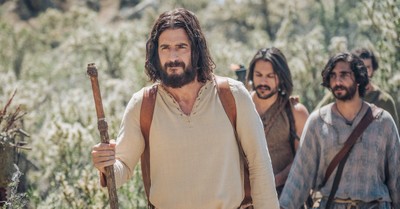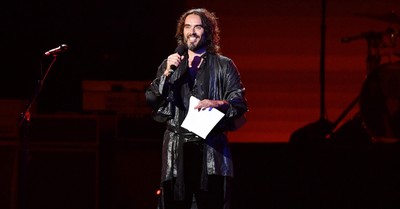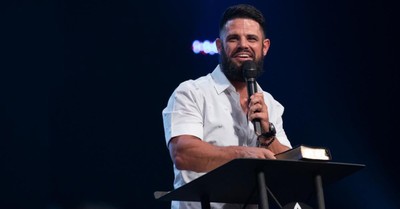Jerusalem (CNSNews.com) - Outside the Church of the Holy Sepulcher in Jerusalem's Old City, Christians from around the world celebrated Good Friday. Lucynoi Skalska and her friend, both Catholics from Poland, were wearing plaited crowns of thorns, identifying with Jesus, whose crucifixion was marked on Friday.
Many Christians have stayed away from the Holy Land for the last four years because of the violence and terrorism, but Christians from around the world are beginning to return to the country, religious sources said.
The Church of the Holy Sepulcher in the Christian Quarter of Jerusalem's Old City was originally built in 330 A.D. by the mother of the Roman Emperor Constantine. It commemorates the hill on which Jesus was crucified and the tomb in which he was buried, according to some church traditions.
The church was destroyed twice during the last 1,600 years, but was rebuilt in the time of the Crusades. Today it is controlled by various church factions.
On Friday, tour groups and individuals from many nations milled around in the courtyard in front of the church.
In one corner of the courtyard, half-a-dozen or so seven-foot wooden crosses were stacked for pilgrims to use. Some lifted them to feel the weight. Others had their pictures taken supporting the cross.
One tall man commented that the cross was heavy and it wasn't even to scale. Imagine how heavy the real one was, he said.
Gloria Abalas, from the Philippines, has been working in Israel as a caregiver for an elderly Jewish woman for four years.
"Every time we come here to celebrate the Holy Week and make the Stations of the Cross," said Abalas, referring to the route Jesus is said to have taken as he carried the cross on the way to his crucifixion.
"I'm feeling I'm near [to] Jesus Christ when I'm here in Jerusalem," Abalas said. "My dream [was] really to come here [to] the Holy Land and we have opportunity to come and to work. We have money and we [are close] to Jesus."
Sheila Allen, a Mormon from the U.S., could hardly speak from the emotion. "It's a dream of a lifetime," she said.
Magnhild and her husband John Steinar Kristoffersen are Lutherans from Norway. "It's very special. I feel we are on holy ground," Magnhild said. "For me it means very much because it was here Jesus was crucified and [rose] from the dead. It's very important to be here."
Christer and Ragnhildog Durfeldt, also from Norway, were in Israel for the first time. "[It's a] special time for us now," said Christer. "We know that we don't have to come here to pray, but it's very exciting to be here and [to visit] some of the places where Jesus has been."
With hardly any English at all, Lucyhoi Skalska and her friend wearing the plaited crowns of thorns conveyed their enthusiasm at being here for the Easter season. Two men who were with them were dressed in clothes that Polish aristocrats wore 750 years ago - thick brocade jackets covered by brightly colored velvet coats with gold sashes and fur hats with plumes.
"The atmosphere is very good," said Skalska. "[It is] the normal atmosphere from 2,000 years ago."
Although the church itself is rugged, built from huge hewn stones, the decor is ornate. Incense urns and dim lights hang from chains and paintings depicting the death and resurrection of Jesus are hung on the walls. There is little light inside except from a round skylight at the top of the dome, dozens of feet above the church floor.
Near the entrance is a large slab where Jesus' body was said to have been laid after he was crucified. On Friday, a bouquet of white flowers was laid on the slab. Some pilgrims knelt to touch the stone. Others kissed it.
Further inside, hundreds of people waited in a long line to enter a structure built inside the church over the place where Jesus' tomb was believed to have been.
According to a priest, forming part of a human chain to direct pilgrims at the door, there are many more pilgrims this year than in the last few years.
'Jewel in East Jerusalem'
Not far from the Church of the Holy Sepulcher, outside the Old City walls is a place known as the Garden Tomb. Referred to by some as the "Jewel in East Jerusalem," the lush gardens surround another empty tomb that is a possible site where Jesus could have been buried.
In 1884 an English general, Charles Gordon, discovered a prominent rocky crag over the area of the gardens, which resembles a skull. According to the Bible, the place where Jesus was crucified was called Golgotha - the place of the skull. Nearby was an ancient tomb.
Gordon raised the money to purchase the gardens and established the Garden Tomb.
Victor Jack, chairman of the Garden Tomb Association board in England, said that tourists are returning to Israel and this year are expecting some 1,500 visitors for the sunrise service in English on Easter morning. That's double what it was last year, he said.
"We have a long way to go before we're up to the [pre]-intifadah levels. When the intifadah started our numbers dropped by 90 percent," Jack told Cybercast News Service.
Tourism, at its peak in Israel and the Palestinian areas before the outbreak of the armed conflict in September 2000, sharply declined in the years of trouble.
"But the last year the numbers have been climbing and at the end of 2004 we had double the numbers we had at the end of 2003," Jack said. "The Americans are now coming back in large numbers. In fact, over these last few days, we've had over a thousand visitors a day. Many of those have been from the States.
"It's good for everybody because the Arabs as well as the Jewish people have all suffered. The economy has been in bad shape because of the lack of tourists," he said.
"This is a very special time," Jack added. "Easter in our Christian calendar is the most memorable time of the year."
On Good Friday, he said, Christians remember "the greatest sacrifice the world has ever seen." And on Easter, they celebrate "the greatest victory the world has ever seen in the resurrection of Jesus from the dead, and so that's why a lot of people love to be here in Jerusalem over Easter," Jack said.
Send a Letter to the Editor about this article.
Christians Flock to Holy Land as Terrorism Ebbs
Julie Stahl
| Jerusalem Bureau Chief
| Published: Mar 25, 2005










